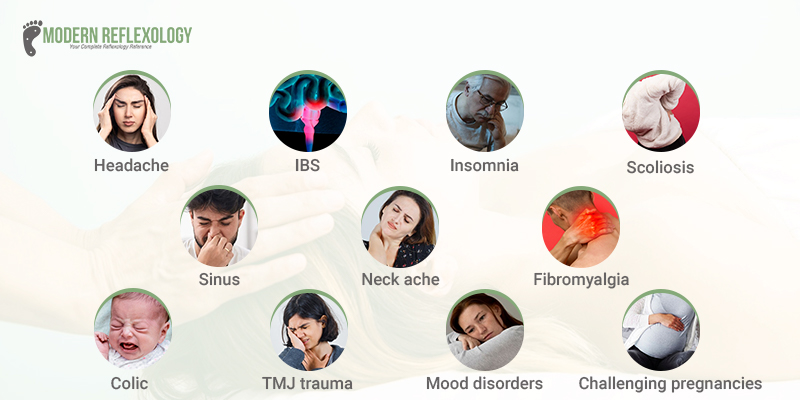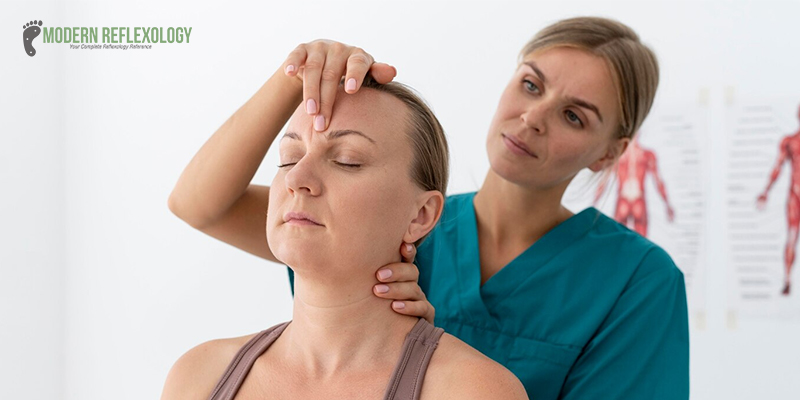A gentle, hands-on method for addressing abnormalities in the craniosacral system—which includes the membranes and cerebrospinal fluid around the brain and spinal cord—is called craniosacral therapy, or CST for short. Supporters of this therapy think that by gently manipulating the sacrum and cranial bones, the body’s natural healing processes can be triggered, improving general health and wellbeing. Regarding its efficacy and safety, there are conflicting views, just like with other alternative therapy.
After receiving craniosacral therapy sessions, some people report notable benefits in a variety of ailments; nevertheless, others are dubious, doubting its scientific foundation and cautioning against certain hazards.
What is Craniosacral Therapy?
A series of manual therapy techniques known as craniosacral fascial therapy (CST) involve a soft, healing touch by practitioners on the bones, soft tissues, and cerebrospinal fluid surrounding the central nervous system. The soft tissues, fluid, and skull comprise the craniosacral system. It provides support to the brain and spine’s central nervous system. The craniosacral system can be gently massaged to improve health and wellness and help relax and release tension that causes discomfort.
- An effective treatment for fatigue and other acute and chronic conditions is CST.
- CST is usually conducted in a calm environment.
- To modify the sacrum (the base of the spine), cranial bones (the head), and subtly regulate the flow of cerebral spinal fluid (CSF), practitioners employ gentle touch and sensitive manual techniques.
One of the two systems that make up the immune system—the other being the circulatory system—is the lymphatic system, which is connected to the CSF. The brain membranes are massaged by these subtle movements that contribute to the appropriate fluid balance surrounding the brain and spinal cord.
Positive outcomes could be obtained from at least three to ten sessions, with maintenance therapy coming after. Chiropractors, massage therapists, physical therapists, and osteopathic physicians can all administer craniosacral massages.
Craniosacral Therapy Benefits

Compression in the head, neck, and back is said to be released by CST. This can reduce discomfort and relax tension in the body as well as the mind. It may also help relieve or release constraints related to the head, neck, and nerves and aid in restoring cranial mobility. People of various ages can benefit from craniofacial sacral therapy. It could be a component of your care for ailments such as:
- Headaches and migraines
- Irritable bowel syndrome (IBS) with constipation
- Insomnia and erratic sleep patterns
- Scoliosis
- Sinus infections
- Neck ache
- Fibromyalgia
- Infants with persistent ear infections or colic
- Recuperation from TMJ trauma, including whiplash trauma
- Mood disorders such as depression and anxiety
- Challenging pregnancies
Although there is a wealth of anecdotal data supporting the effectiveness of CST, further studies are required to make this conclusion. While some studies indicate that it might only work for babies, toddlers, and kids, there is evidence that it can help reduce stress and tension.
Craniosacral Therapy Cost could be between 1500/- to 8000/- per session.
Procedure And Technique
Your doctor will inquire about your symptoms and any underlying medical conditions when you first come for your appointment. Be sure to arrive at your appointment wearing comfortable attire, as you will be fully dressed during the procedure. You will probably start your hour-long session by reclining on your back on the massage table. Your head, foot, or somewhere in the middle of your body could be where the practitioner starts. The provider will gently hold your head, foot, or sacrum with five grams of pressure so you can hear their tiny rhythms. To restore the regular flow of the CSF fluids, they could gently press on you or move you if they think it’s necessary. They might support one of your limbs while applying tissue-release techniques.
Different feelings are felt by various patients during treatment. These could consist of:
- Experiencing profound calm
- Slipping off to sleep, then waking up with memories or seeing colors or feeling pulsations
- Experiencing a numbing, “pins and needles” sensation
- Feeling either hot or cold
How Does Craniosacral Therapy Work?

The main anatomical components of the central nervous system are your brains and spinal cords. The craniosacral system, which consists of fluid and membranes that smother, shield, and hydrate your neurons, has a significant impact on this.
Every day, your body faces physical obstacles that it must overcome. Regretfully, those challenges frequently cause bodily tissues to constrict, which distorts the thoracic-sacral system. Tension is created around the brain and spinal cord due to such abnormalities causing muscular tissues to contract. This conundrum could make it more difficult for the central nervous system and potentially other cells with which it interacts to function normally.
Thankfully, simple touch processes can be used to detect and address these restrictions. The craniosacral therapist uses light touch to assess the craniosacral system by feeling various body parts to ascertain the rhythm, range, and ease of mobility of the cerebrospinal fluid that surrounds the brain and spinal column. Any limitations in the craniosacral system that impact the central nervous system can then be addressed with gentle approaches. Through activation of the brain’s surrounding tissue and improvement of the body’s ability to adapt to flaws, Craniosacral massage therapy effectively relieves a wide range of health problems, such as persistent pain and physical injuries.
Final Words
In conclusion, craniosacral therapy continues to be a topic of interest in the field of alternative medicine since it provides a special method of treating a variety of medical issues. We now know more about the basic principles of this therapy, its apparent effectiveness, and the possible advantages and disadvantages of using it. Although a lot of people have praised craniosacral therapy and attested to its efficacy in treating a variety of illnesses and enhancing general well-being, it’s crucial to approach the practice critically and recognize its limitations. There is conflicting scientific data about its effectiveness; some research points to favorable effects, while other findings are equivocal.
In the end, whether craniosacral therapy “works” will differ based on personal variables including their health, how well they respond to treatment, and the practitioner’s ability. As with any alternative therapy, the key to figuring out whether it’s appropriate and helpful for a certain person’s requirements is to approach it with an open mind but also with discernment. A fuller understanding of the mechanics, effectiveness, and possible advantages of modalities like craniosacral treatment for holistic health and wellness will be facilitated by continued research and inquiry as the area of alternative medicine develops. People can maximize their health and vitality by navigating the wide landscape of therapeutic techniques with knowledge and dedication to their well-being.

Comments are closed